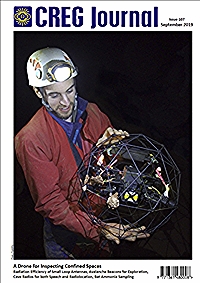
- The most recent issue to be published was 132
- For further information, please see Publishing/Despatch Schedule
- Database last updated on Mon, 01 Dec 2025 18:30:34 +0000
- Online access is currently available for all issues. Some of
the older issues are bit-map scans rather than digital copies.
journal scans.
- Online voting for CREG articles was withdrawn in June 2022. For info see
Voting for CREG articles
Contents of journal 107
September 2019
This page may take a few
seconds to load. Please wait ...
- CREG Journal 107 (0-24)
(PDF 3.0MB)
  Individual articles may be available below Individual articles may be available below
- This issue has a cover date of September 2019 and was published on 1 September 2019.
-
- Front Cover (1)
(PDF 365KB)

- The Flyability Elios 2 drone following a flight. The external cage prevents damage to critical moving parts, despite some evidence being visible that the drone came into contact during the flight. Photo: Flyability
-
- Contents (2)
(PDF 257KB)

- List of contents and masthead information. CREG Autumn 2019 Field Meeting.
-
- Introducing the Elios 2 Drone for Aerial Inspections of Confined Spaces (3-5)
(PDF 492KB)

- Elios 2 is an aerial drone for carrying out inspections in confined spaces, which is protected from collisions by a carbon cage. Marc Gandillon, Marketing Manager at Flyability, outlines this new product and highlights its use in a recent exercise at the Aven d’Orgnac cave in France.
-
- The Inductance of a Wire Hoop (6)
(PDF 251KB)

- Many textbooks and webpages quote a formula for the inductance of a thin wire hoop, but few actually give the derivation. David Gibson had been confused by formulas that appeared to differ by a factor of two but has eventually decided where the subtle difference lies. This leads to an interesting possibility for the design of a wideband loop antenna with a lower Q-factor than is normally achievable.
-
- Determining Ammonia Concentrations in Bat Caves with Passive Air Samplers (7-9)
(PDF 549KB)

- Caves that are home to large colonies of bats may have atmospheres with significant concentrations of gaseous ammonia. Guy Van Rentergem describes an approach to measuring concentrations over time using Radiello diffusive air samplers.
-
- Wet & Dry (10)
(PDF 239KB)

- Mike Bedford reports on rugged, waterproof, and generally cave-proof equipment for use in conjunction with cave data logging.
-
- Response Characteristics of Instruments and Sensors (11-12)
(PDF 429KB)

- Bob Mehew discusses the response characteristics that instruments and sensors can exhibit, and considers how, unless properly understood, this can result in erroneous conclusions being drawn when using data loggers and similar instruments.
-
- Building Blocks (13)
(PDF 258KB)

- Some considerations if wireless connectivity is required for a project, by Tony Haigh.
-
- Using Cave Radios for Combined Speech and Radiolocation (14-16)
(PDF 785KB)

- Transporting radiolocation equipment as well as cave radios can sometimes be impractical. Chris Ross shows that, in some circumstances, cave radios are adequate for radiolocation, despite operating on relatively high frequencies.
-
- The Radiation Efficiency of a Small Loop Antenna (17-18)
(PDF 313KB)

- For cave radio applications, we are not normally interested in the radiation from a loop antenna because the distance over which we are working is small (relative to a wavelength) and so only near-field effects need to be considered. However, it is still interesting to consider the radiation field, and to express the radiation efficiency in terms of the specific aperture where, just as for near-field operation, the number of turns on the antenna does not affect the result. David Gibson explains radiation resistance, summarises the equations and shows how the skin effect in the wire and the proximity effect between turns of the antenna winding can be taken into account.
-
- Using Avalanche Beacons in Cave Exploration (19-20)
(PDF 361KB)

- Avalanche beacons are low-cost transceivers operating on 475kHz. Atanas Rusev describes how he has used them for finding new entrances into large cave systems, and to identify dig locations for joining two caves.
-
- Letters to the Editor (21)
(PDF 283KB)

- Spot the Polarity Luc Le Blanc, Maintaining Concentration Bob Mehew.
-
- Web Watch (21) For download see previous item
- Every search of the Internet seems to turn up interesting gems. Peter Ludwig reveals the results of some of his recent explorations...
-
- We Hear (22)
(PDF 298KB)

- Roundup of news and events – Mike Bedford brings us the latest to impact the world of cave radio and electronics. Fuel Cells to Become Mainstream? Rotating Magnet Antennas, Gas Sensor Donation to BCRC
-
- Data Transmission at the Cave Monitoring Centre (23)
(PDF 415KB)

- The British Cave Research Association has teamed up with Buxton Civic Association to provide a facility at Poole’s Cavern show cave, in Derbyshire, UK, known as the British Cave Monitoring Centre. Tinytag data loggers supplied by Gemini Data Loggers can be monitored remotely via a web browser. David Gibson describes some of the problems encountered during the set-up – including difficulties with the router, firewall and PC.
-
- The Adventures of GREG (24)
(PDF 285KB)

- Illustration by Adrian Higgins, and words by Mike Bedford.
-

|

View Contents:

BCRA is a UK registered charity and is a constituent body of
the British Caving Association,
undertaking charitable activities on behalf of the BCA.
BCRA publishes a range of periodicals and books.
Click here for further information.
|
Searching
To Search our pages using Google, type a search
string in the box at the top of the page and hit your Return key
You can also search our publications catalogue at the British Caving Library
The CREG Journal Search Engine is a new, powerful search engine which will, sometime, be extended
to cover Cave & Karst Science. We have a keyword search facility on our Cave Science Indexes pages but this may be rather out-of-date.
|
For staff use: Link to Database
Show/Hide
download figures next to each item (if available and non-zero; you might need to refresh page first). Counters last
reset on Thu 03-Jan-2019 17:29:28 +00:00. The figures are non-unique
click-throughs.
|









